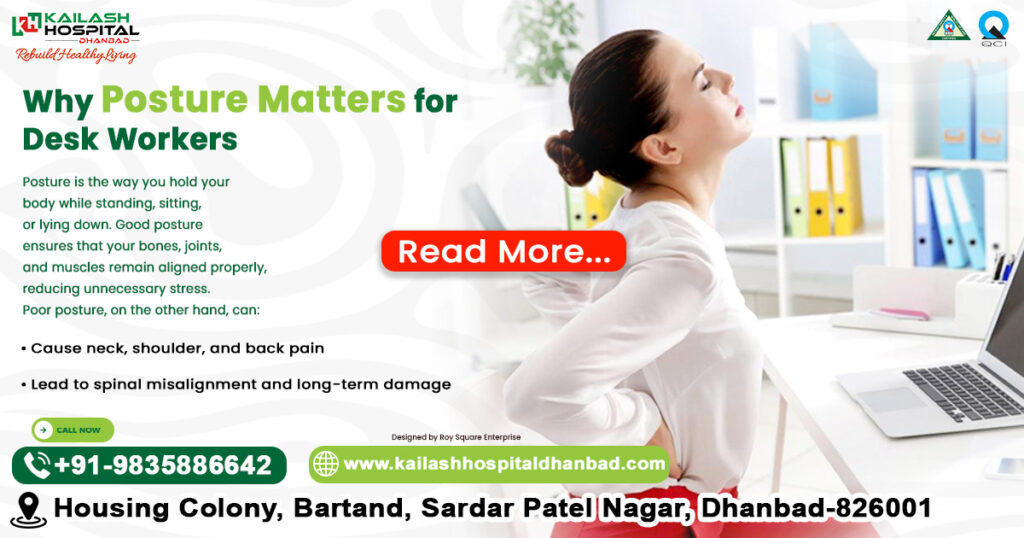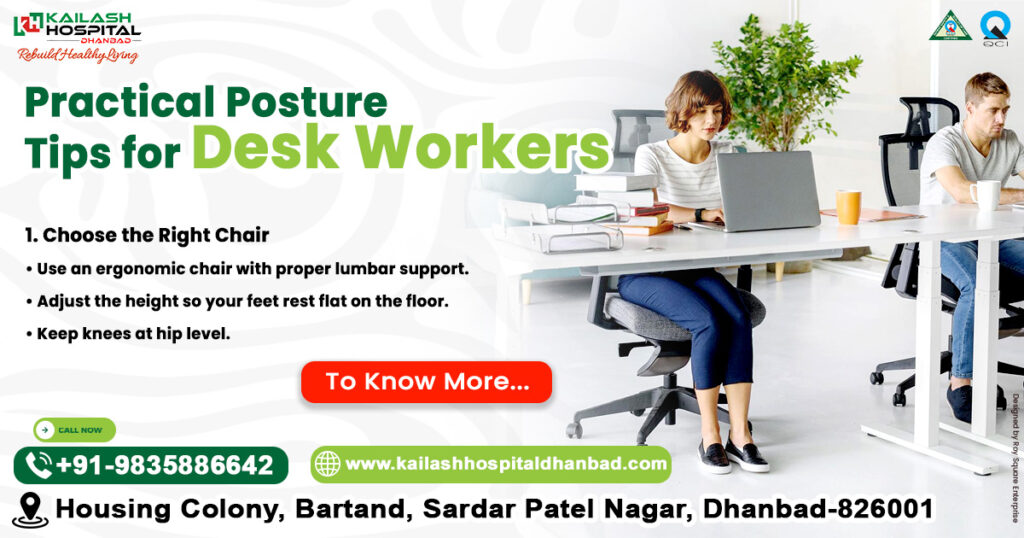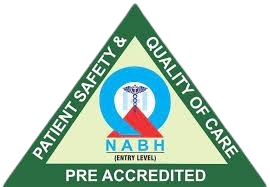In today’s digital world, most professionals spend 6–10 hours a day sitting at their desks, often glued to laptops, computers, or smartphones. While this lifestyle improves productivity, it also comes with a hidden cost: back and neck pain. Poor posture, prolonged sitting, and lack of movement are major reasons why more and more young professionals are suffering from orthopedic problems once seen mostly in older adults.
According to Dr. Ashish Bajaj, Consultant Orthopedics, Kailash Hospital, Dhanbad, one of the most common reasons patients visit him is due to pain and stiffness in the spine, shoulders, and neck caused by poor desk posture. (Posture Tips for Desk Workers ) The good news is that these issues are preventable with the right awareness, simple posture corrections, and lifestyle changes.
This blog will explore the importance of posture, common desk-related problems, practical tips to maintain good posture, exercises, and expert advice from Dr. Ashish Bajaj to keep your spine healthy and pain-free.

Why Posture Matters for Desk Workers
Posture is the way you hold your body while standing, sitting, or lying down. Good posture ensures that your bones, joints, and muscles remain aligned properly, reducing unnecessary stress. Poor posture, on the other hand, can:
- Cause neck, shoulder, and back pain
- Lead to spinal misalignment and long-term damage
- Reduce lung capacity and energy levels
- Contribute to headaches and fatigue
- Decrease productivity and focus
As Dr. Ashish Bajaj highlights, “Most cases of back and neck pain in young professionals are not due to serious diseases, but rather the result of simple posture problems that are ignored over time.”
Common Posture Problems in Desk Workers
- Forward Head Posture – Leaning the head forward while looking at screens.
- Rounded Shoulders – Slouching shoulders due to poor chair support.
- Hunched Back – Sitting with the spine curved for long hours.
- Crossed Legs – Causing imbalance in hips and lower back.
- Slouched Sitting – Sitting without lumbar (lower back) support.
These issues often develop gradually and may initially feel harmless but can cause chronic conditions if not corrected. (Posture Tips for Desk Workers )

Practical Posture Tips for Desk Workers
1. Choose the Right Chair
- Use an ergonomic chair with proper lumbar support.
- Adjust the height so your feet rest flat on the floor.
- Keep knees at hip level.
2. Screen at Eye Level
- Your monitor should be at eye height, about an arm’s length away.
- Avoid bending your neck down to look at the screen.
3. Keep Feet Flat
- Do not cross your legs.
- Use a footrest if your chair is too high.
4. Position Your Keyboard & Mouse Properly
- Keep elbows at 90 degrees.
- Avoid overstretching your arm to use the mouse.
5. Follow the 20-20-20 Rule
Every 20 minutes, look at something 20 feet away for 20 seconds. This relaxes your eyes and reduces strain.
6. Take Micro Breaks
Stand up, stretch, or walk for 2–3 minutes every hour.
7. Maintain Neutral Spine Alignment
- Keep back straight and shoulders relaxed.
- Avoid leaning too forward or backward.
8. Support Your Lower Back
- Use a small cushion or lumbar roll behind your lower spine if your chair lacks support.
9. Avoid Using Laptop on Bed
Bed working forces awkward postures, straining your spine. Always use a desk setup.
10. Stay Hydrated & Active
Dehydration reduces disc lubrication in the spine. Drinking enough water and moving regularly keeps your joints healthy.
Dr. Ashish Bajaj emphasizes that “Desk jobs don’t have to mean back pain. A few smart adjustments in posture can make a huge difference in long-term spinal health.”
Simple Desk Exercises for Back & Neck Relief
- Neck Rotations – Slowly rotate your head clockwise and anticlockwise.
- Shoulder Shrugs – Raise shoulders up and down to release stiffness.
- Seated Spinal Twist – Sit straight, twist gently to the right and left.
- Hamstring Stretch – Extend one leg forward and lean gently.
- Cat-Cow Stretch (if space allows) – Stretch spine alternately forward and backward.
Performing these simple stretches daily helps in preventing stiffness and muscle fatigue. (Posture Tips for Desk Workers )
Lifestyle Habits That Support Good Posture
- Exercise regularly to strengthen core muscles.
- Avoid long screen time after office hours.
- Sleep on a firm mattress for proper spinal support.
- Use both shoulders for carrying bags instead of one.
- Keep phones at eye level to prevent “text neck.”

When to See a doctor
Consult an orthopedic specialist Dr. Ashish Bajaj at Kailash Hospital, Dhanbad if you experience:
- Persistent back or neck pain lasting more than 2 weeks.
- Numbness or tingling in arms or legs.
- Severe stiffness affecting daily activities.
- Sudden sharp pain after prolonged sitting.
Early consultation helps prevent minor posture problems from turning into chronic spinal conditions.
Good posture is not just about sitting straight—it’s about building a healthy lifestyle that keeps your spine strong, your body pain-free, and your productivity at its peak. With expert guidance and simple daily habits, desk workers can stay active, comfortable, and confident.
Top 10 FAQs About Posture Tips for Desk Workers
- Why does poor posture cause back and neck pain?
Because it puts extra stress on muscles, ligaments, and the spine. - How should I sit at my desk to avoid pain?
Sit with your back straight, shoulders relaxed, feet flat, and screen at eye level. - What is the best chair for desk work?
An ergonomic chair with lumbar support is recommended. - Can sitting too long cause permanent damage?
Yes, prolonged poor posture can lead to spinal misalignment and chronic pain. - How often should I take breaks from sitting?
Every 30–60 minutes, stand up, stretch, or walk. - Is a standing desk better than sitting all day?
Alternating between sitting and standing reduces spinal stress. - Does exercise help posture?
Yes, strengthening core and back muscles improves posture naturally. - Can posture problems lead to headaches?
Yes, forward head posture can cause tension headaches. - How long does it take to improve posture?
With daily habits and exercises, noticeable changes may appear in 2–6 weeks. - Who should I consult if posture pain persists?
An orthopedic specialist Dr. Ashish Bajaj at Kailash Hospital, Dhanbad. (Posture Tips for Desk Workers )
Top 10 Myths vs Facts About Posture Tips for Desk Workers
Myth 1: Good posture means sitting stiffly all day.
Fact: Good posture is relaxed and natural, not rigid.
Myth 2: Only older people suffer posture problems.
Fact: Even young professionals develop posture-related pain.
Myth 3: Expensive chairs alone fix posture.
Fact: Posture depends on habits, not just chairs.
Myth 4: Slouching occasionally is harmless.
Fact: Repeated slouching leads to long-term spinal stress.
Myth 5: Standing desks eliminate posture issues.
Fact: Standing too long can also cause pain; balance is key. (Posture Tips for Desk Workers )
Myth 6: Posture correction is instant.
Fact: It requires consistent practice and awareness.
Myth 7: Back pain from posture is normal and doesn’t need treatment.
Fact: Ignoring pain can lead to chronic spine problems.
Myth 8: Exercise alone can fix bad posture.
Fact: Exercise helps, but daily sitting habits matter more.
Myth 9: Crossing legs is comfortable and fine.
Fact: It misaligns hips and increases back strain.
Myth 10: Once you have posture issues, they can’t be corrected.
Fact: With proper care, most posture problems are reversible. Myth 10: Once you have posture issues, they can’t be corrected.
Fact: With proper care, most posture problems are reversible. (Posture Tips for Desk Workers )



